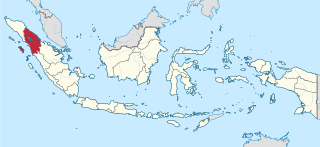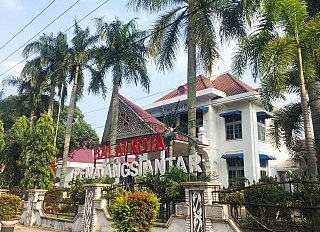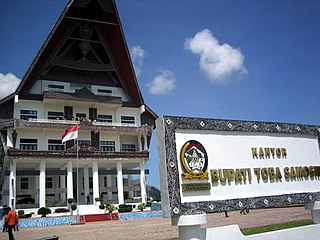This article needs additional citations for verification .(September 2024) |
Boho is a Batak village on the island of Samosir on Lake Toba, in the Indonesian province of North Sumatra. [1]
This article needs additional citations for verification .(September 2024) |
Boho is a Batak village on the island of Samosir on Lake Toba, in the Indonesian province of North Sumatra. [1]
Boho, unlike many other villages, does not get many tourists. It contains about 35 homes, including traditional Batak homes, and six shops that sell toddy (palm wine), coffee, noodles, and other snacks or soft drinks. Boho has a small school.
It has a sister village named Harian Boho, which is about 30 minutes away. Buses often pass through Boho. The bus journey from Medan takes about 3–4 hours.

Lake Toba is a large natural lake in North Sumatra, Indonesia, occupying the caldera of the Toba supervolcano. The lake is located in the middle of the northern part of the island of Sumatra, with a surface elevation of about 900 metres (2,953 ft), the lake stretches from 2.88°N 98.52°E to 2.35°N 99.1°E. The lake is about 100 kilometres long, 30 kilometres (19 mi) wide, and up to 505 metres (1,657 ft) deep. It is the largest lake in Indonesia and the largest volcanic lake in the world. Toba Caldera is one of twenty geoparks in Indonesia, and was recognised in July 2020 as one of the UNESCO Global Geoparks.

North Sumatra, also called North Sumatra Province, is a province of Indonesia located in the northern part of the island of Sumatra, just south of Aceh. Its capital and largest city is Medan on the east coast of the island. It is bordered by Aceh on the northwest and Riau and West Sumatra on the southeast, by coastlines located on the Indian Ocean to the west, and by the Strait of Malacca to the east.

Samosir, or Samosir Island, is a large volcanic island in Lake Toba, located in North Sumatra Province on the island of Sumatra in Indonesia. Administratively, Samosir Island is governed as six of the nine districts within Samosir Regency. The lake and island were formed after the eruption of the Toba supervolcano some 75,000 years ago.

Berastagi, is a town and district of Karo Regency situated on a crossroads on the main route linking the Karo highlands of Northern Sumatra to the coastal city of Medan. Berastagi town is located around 66 km (41 mi) south of Medan and about 1,300 m (4,265 ft) above sea level. The village rose to significance when Dutch settlers in Sumatra opened a boarding school there in the 1920s.

Batak is a collective term used to identify a number of closely related Austronesian ethnic groups predominantly found in North Sumatra, Indonesia, who speak Batak languages. The term is used to include the Karo, Pakpak, Simalungun, Toba, Angkola, Mandailing and related ethnic groups with distinct languages and traditional customs (adat).

Pematangsiantar, and also known as the City of Pematangsiantar, is an independent city in North Sumatra Province of Indonesia, surrounded by, but not part of, the Simalungun Regency, making Pematangsiantar an enclave within Simalungun Regency. Pematangsiantar formerly had the status of a second-level district and was the administrative centre of the surrounding Regency, but in 1986 it was elevated to Kota (City) and separated from the Regency.

Karo Regency is a landlocked regency of North Sumatra Province of Indonesia, situated in the Barisan Mountains. The regency, which was established on 7 November 1956, covers an area of 2,127.25 square kilometres (821.34 sq mi) and according to the 2010 census it had a population of 350,479, increasing to 404,998 at the 2020 Census; the official estimate as at mid-2023 was 420,799, comprising 208,600 males and 212,200 females. 60.99% of the regency is forested. Its regency seat is the town of Kabanjahe. The Batak Karo language is spoken in the regency, as well as the Indonesian language. It borders Southeast Aceh Regency in Aceh to the west, Deli Serdang Regency and Langkat Regency to the north, Dairi Regency and Toba Samosir Regency to the south, and Deli Serdang Regency and Simalungun Regency to the east.

Toba Batak is an Austronesian language spoken in North Sumatra province in Indonesia. It is part of a group of languages called Batak. There are approximately 1,610,000 Toba Batak speakers, living to the east, west and south of Lake Toba. Historically it was written using the Batak script, but the Latin script is now used for most writing.

Dairi Regency is an inland regency on the western shore of Lake Toba in North Sumatra Province of Indonesia. The regency was created on 23 September 1964 from what were previously the north-western districts of North Tapanuli Regency; however the southern districts of this new regency were in turn split off on 25 February 2003 to form the new Pakpak Bharat Regency. The reduced regency covers an area of 1,927.80 square kilometres (744.33 sq mi) and it had a population of 269,848 people at the 2010 Census and 308,764 at the 2020 Census; the official estimate as at mid 2023 was 324,747 - comprising 162,928 males and 161,819 females. Its administrative seat is at the town of Sidikalang.

Simalungun Regency is a regency in North Sumatra Province of Indonesia. Its seat was formerly at Pematangsiantar, but this city was under Law No.15 of 10 March 1986 was separated from the Regency and made into an independent city (kota), although it remains geographically surrounded by the regency, whose new administrative seat is at Raya, while the regency's two most populous districts are Bandar and Siantar. The regency now covers an area of 4,372.5 square kilometres, and at the 2010 census it had a population of 817,720; at the 2020 Census this had risen to 990,246, of whom 497,314 were males and 492,932 were females; the official estimate as at mid 2023 was 1,035,920 - comprising 521,262 males and 514,658 females.

Toba Regency is a landlocked regency in North Sumatra. Its seat is Balige. The regency covers an area of 2,021.8 square kilometres; it had a population of 173,129 at the 2010 census and 206,199 at the 2020 Census; the official estimate as at mid 2023 was 213,850. Although landlocked, the regency includes the eastern shore of the vast inland Lake Toba.

Patuan Bosar SinambelaginoarOmpu Pulo Batu, better known as Si Singamangaraja XII, was the last priest-king of the Batak peoples of north Sumatra. In the course of fighting a lengthy guerrilla war against the Dutch colonisation of Sumatra from 1878 onwards, he was killed in a skirmish with Dutch troops in 1907. He was declared a National Hero of Indonesia in 1961 for his resistance to Dutch colonialism.

The Toba Batak people are the largest ethnic group of the Batak peoples of North Sumatra, Indonesia. The general term ‘Batak’ is sometimes used to refer to the Batak Toba people, for one thing because the Toba people are the largest sub-group of the Batak ethnicity, for another because they tend to self-identify as merely Batak instead of ‘Toba’ or ‘Batak Toba’, contrary to the habit of the Karo, Mandailing, Simalungun, Pakpak communities who commonly self-identify with their respective sub-groups.

Sigalegale is a wooden puppet used in a funeral dance performance of the Batak people in Samosir Island, Northern Sumatra. Sigale Gale is a well-known feature for visiting tourists. During the dance, the puppet is operated from behind, like a marionette, using strings that run through the ornate wooden platform on which it stands. The setup enables its arms and body to be moved and its head to turn.

Batak architecture refers to the related architectural traditions and designs of the various Batak peoples of North Sumatra, Indonesia. Six groups of Batak speak separate but related languages: the Angkola, the Mandailing to the south, the Toba, to the north the Pakpak/Dairi, the Simalungun, and the Karo. While the groups are now Muslim or Christian, elements of the ancient Batak religion remain, particularly amongst the Karo.

Huta Bolon Museum of Simanindo is a museum on in the village of Simanindo on Samosir Island in Samosir Regency, North Sumatra, Indonesia. The museum is housed in the former home of Rajah Simalungun, a Batak king who had 14 wives. The roof was decorated with 10 buffalo horns representing the 10 generations of the dynasty. The museum's collection includes brass cooking utensils, weapons, crockery from the Dutch and Chinese, sculptures, and Batak carvings. Dance performances are given daily and audience participation encouraged.

A sopo is a treasury structure in the architecture of the Toba Batak people from North Sumatra, Indonesia. Its form is similar to that of a Batak traditional house with the exception of being smaller in size and a construction ritual that is the opposite of a Batak house. Sopo is used as a repository for various items, e.g. rice, magical items, or trophies. Sopo can also be used as a meeting point for social activities.

Martinus Dogma Situmorang OFMCap was an Indonesian Roman Catholic bishop.

Tapanoeli Residency was an administrative subdivision of the Dutch East Indies with its capital in Sibolga. It was located in northern Sumatra and existed in various forms from 1844 until the end of Dutch rule in 1942. The area it encompassed at various times corresponds to most of the western coast of the current day Indonesian province of North Sumatra and parts of Aceh, including much of the traditional heartland of Batak people. Lake Toba, a historically important crater lake, was also within the borders of the Residency.

Tortor is a traditional Batak dance originating from North Sumatra, Indonesia. This dance was originally a ritual and sacred dance performed at funerals, healing ceremonies, and other traditional Batak ceremonies. For the Batak people, tortor dance has both cultural and spiritual values. Through this dance, people express their hopes and prayers. Demonstrations of attitudes and feelings through this dance describe the situation and conditions that are being experienced.
3°11′N125°31′E / 3.183°N 125.517°E